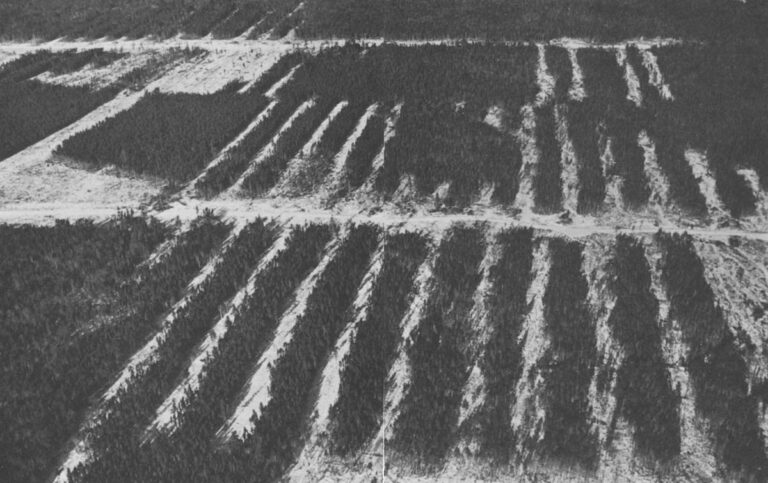Maine’ vast wildlands contain the most uncommon forest in America.
Known in the Eastern U.S. as the legendary Maine Woods, the tall stands of spruce, fir, pine, and hardwoods sweep across almost all of the 10-million acre region, making Maine the most heavily wooded state in the country. Ninety percent of the region is privately owned, half of that by multinational pulp and paper corporations. It is an ownership pattern unrepeated on that scale anywhere.
To the casual eye, the forest seems virtually boundless. With a phenomenal capacity for natural regeneration, it fuels the state’s largest manufacturing industry, papermaking, while perpetuating simultaneously the myth that most of Maine is still the “dark and intricate wilderness” of Henry David Thoreau’s time.

The forest has permeated the state’s character from the beginnings of settlement 350 years ago, when colonists encountered solid masses of giant thickets. The white pine on the state seal and flag symbolizes that the forest is, in essence, the heart of Maine. Flying above the forest canopy today from Moosehead Lake to where the Allagash Wilderness Waterway meets the St. John River, just the sight of such an immense resource instills in most observers a sense of awe. To the timberland owner, it is a prized private commodity that has assured sustained industrial profits. To the canoeist or backpacker, it continues to be the last remaining expanse east of the Adirondack Forest Preserve where one can have a two-week long “wilderness” pack trip–crucial in writer Aldo Leopold’s mind for “internal self-renewal.”
When Thoreau trekked through empty, unsettled wildlands in the 1850s, there was no conflict over the use of the mountain and lake-studded Maine Woods. Lumbermen had not begun to deplete the area’s timber, there was little recreational use, and fish and wildlife were abundant.
But those days of plenty are gone, and all is not well in the Maine Woods. There is no more untouched, unexplored wilderness. The forest has been plundered of its finest timber and has deteriorated to the point that it is an immense “junk woods,” according to Dr. Lloyd Irland, Maine’s state economist, who formerly taught at the Yale School of Forestry and Environmental Studies. Irland and professional foresters agree that most of the timberland are diseased, dying, or of poor quality–although still generating profits. The age of the forest is dangerously unbalanced between very young stands and old stands that are slow growing. There is a critical deficit in the economically important middle-aged stands. In some areas, the annual timber harvest equals or exceeds new growth.
At the same time, demands on the whole forest environment have escalated at an almost breathless pace, creating a sense of crisis about the state’s most important industry and treasured natural resource.
State Planning Office director Richard Barringer said the situation is “a metaphor for what goes on in the world with resource depletion, multiple use conflicts and man’s intervention for his own purposes. The forest is a resource that has its own requirements, and those requirements seldom, if ever, coincide with man’s,” he said.
There are four reasons for the crisis in the Maine Woods: the inability of the spruce/fir forest to sustain the current rate of harvesting; massive expansion of the logging road network; unprecedented pressure from recreationists; and the potential threat from acid rain, ozone, and other pollutants.
Many people close to the problems doubt that existing state policies can protect the abiding public interests. And the average citizen doesn’t know what to do. There is only the beginning of a widespread recognition of the exigency, due to the traditional complacency Mainers have had about such an abundant resource and because of their geographic distances from the Maine Woods. Most of Maine’s population of 1.1 million lives in a narrow strip along the 3,500-mile coastline.
The most immediate–and most agreed upon–crisis is the projected demise of the spruce and fir forest, upon which the paper and lumber industries depend. Years of “mining” the forest for its best timber, the lack of investment in forest improvement, over-expansion of the industry, and the cyclic infestation of spruce budworm which eats the growth of spruce and fir, have created the problem. After a 15-year infestation, the insect epidemic is on the wane. By the time it is over, foresters estimate that 25 to 30 million cords of wood will be lost. Consequently, the wood supply won’t be able to feed the paper and lumber industries at their present production levels. That shock will occur within 20 to 30 years. Maine Forest Service director Kenneth Stratton said the sawmill industry “is already feeling the brunt” because lumber-size spruce and fir are disappearing first.
Without a massive investment in intensive forest improvement to accelerate growth of a new spruce/fir forest, Maine’s economic health is threatened. Besides the decline of the lumber industry, economists forecast paper mill shutdowns or capacity reductions and a serious rise in unemployment. Currently, the paper and lumber industry accounts for one-third of the manufacturing jobs in Maine and 43 percent of the state’s manufactured product, valued at $2.7 billion. Maine could lose its position as the nation’s second largest paper-producing state, with 3.65 million tons, just behind first-ranked Wisconsin.
There is reason, however, to doubt whether the needed forest improvement investments will be made on a large scale. The past wood supply abundance meant industry had no need to make such investments; it wouldn’t have been economic to do so. There were no government requirements or incentives, like those of neighboring Canadian provinces. So, there is a history of complacency that would have to be overcome by present management. Additionally, prices for spruce and fir, which provide most of the pulp for papermaking, remain low due to the current glut of budworm-salvaged wood.
“It makes it difficult for Maine-based forest managers to convince their out-of-state corporate headquarters to make the substantial investments required for Maine’s future,” said Charles Hewett, director of the Maine Audubon Society and past director of the forest resource policy program at Dartmouth College. Moreover, Robert Hintze, woodlands manager for International Paper Co. (IP), pointed out that the industry currently is “not particularly healthy. It’s not making money as a whole” and that affects his investment decisions, he said. Maine mills are struggling harder than ever to survive against increasingly strong foreign competitors in a world market with a paper glut.
The proposed Reagan tax reform package adds to the unlikelihood of new forest investments, Hewett said, because it would make timber management more costly than it already is. The reform bill would require landowners to spread out over many years the expenses of forest management, rather than write them off in the year incurred. It also would increase the capital gains rate paid on harvested timber. The intensity of industry’s reaction to the bill is evidenced in its rhetoric. IP’s Hintze said the bill would threaten “our ability to exist as an industry.” Robert Cope, general manager for Champion International Corp.’s Maine operation, called the Reagan plan “a disaster. The guy who is in charge of all the timberlands (for Champion) has said, ‘If this bill passes, I guarantee you we will never plant another tree. Period.’ “
There are questions as to how far the public would support intensive management, which to date in Maine has mostly meant increased controversial clear-cutting and herbicide spraying (with chemicals that kill “weed” species which compete with preferred trees). It would mean dramatic aesthetic changes to the region the public perceives as wilderness. Some people fear there might be wholesale conversion of the natural landscape to Southern-style one-crop tree plantations that are “wildlife deserts.” Others are concerned about the long-term effects of intensive management on soil nutrients, tree productivity, wildlife, and streams draining harvested watersheds.
Those kinds of worries have been aggravated of late by the explosion of whole-tree harvesting, a process in which junk trees–or any tree, for that matter–can be profitably transformed into pulp or into wood fuel. In 1985, nearly 1.7 million tons of chips were produced from 41,300 acres of forest, making biomass a fledgling industry in itself. Maine Audubon’s Hewett said, “If biomass is not carefully managed, it has the potential to seriously disrupt nutrient cycles and thus seriously reduce forest productivity.”
Road-building into remote areas of the Maine Woods is a part of the crisis that threatens the essential character of the wildlands. State Planning Office director Richard Barringer believes it is an issue of more urgency than the current furious public debate over proposed high-level nuclear waste burial in Maine.
Economic trends undermined log driving on Maine’s rivers. By the early 1970s, bulldozers were pushing mainline haul roads into the back country to provide new avenues of wood transport to market. Until then, there were large areas of forest inaccessible by vehicle, and it was easy to see why people still believed it was true wilderness.
Today, at least 11,500 miles of woods roads–half the number of the state’s paved highway miles–crisscross the forest.
Barringer pointed out that for the first time the road expansion is opening up all of the Maine woods to harvesting and management. By the next decade, there will be virtually no roadless areas on privately owned timberlands. If nothing else, the road network is overwhelming evidence that the Maine Woods is not a wilderness but, in fact, an industrialized forest. Any classic wild forest that remains is to be found only in tiny pockets, virtually all of it on the smidgen of Maine’s publicly owned land. Of the state’s 22 million acres, 17 million acres are privately held, giving Maine the lowest proportion of public land of any state in the U.S.

The greater accessibility into the far reaches of the forest has not escaped notice of recreationists, especially along the East Coast. Figures from the state Bureau of Parks and Recreation attest to crowds of recreationists turning to the Maine Woods as a playground and bringing with them a new style of motorized, boisterous fun-seeking. In 1985, 156,000 people used the popular West Branch of the Penobscot River area, more than double the number 10 years ago. The more northerly Allagash Wilderness Waterway attracted 11,598 visitors, an increase of almost 30 percent since 1976. “The Maine woods is a place you can’t go anymore and be away from people,” observed economist/ canoer Irland. “You’ll be sitting in your canoe on the Allagash Wilderness Waterway and someone will come putt-putting up in a rnotorboat. Or you’re deep in the woods and someone will roar by on an all terrain vehicle.” Barringer added that the demise of solitary experiences will “change the spiritual relationship that people have with the Maine Woods, and that’s a great loss.” A few months ago, a group of six major landowners and managers announced that this summer they will control recreational access to 225,000 acres of the Maine Woods, due to vandalism, litter, overcrowding, and liability problems.
Adding to the problems of wood supply, road-building. and recreation is the air pollution scare. Some tests have shown that rain falling in Maine is 10 times more acidic than it was only 30 years ago. Eight high-altitude lakes have been identified to have acid levels at or above the critical level for fish life, and a Maine salmon study has found aluminum and acid in small tributaries that could be toxic to young salmon. Dr. Ivan Hernandez, a University of Maine forest soils expert, said the “multiple effect” of acid rain, ozone, and heavy metals may be more damaging to forests than to lakes. Increasing data indicates that the high elevation forests of the Eastern U.S., including Maine, are experiencing a growth slowdown, particularly among spruce and fir. Yet in Maine, the forest community has not publicly expressed much concern.
The limited monitoring for ozone suggests it has damaged white pine in Acadia National Park on the coast at Bar Harbor. And the Natural Resources Council has reported that heavy metal concentrations, especially lead, in forest soils have risen dramatically in this century. A number of studies in Maine and New Hampshire show a close link between the metals pollution and industrial development of the Northeast.
Adding to the sense of crisis is the upheaval in corporate ownership, top management, and business conditions. Familiar corporate names are disappearing, and new multinational corporations are taking over, creating a greater feeling of distance between Maine citizens and the absentee landlords who, to a significant degree, control their livelihoods. Top executives now tend to come from backgrounds in finance, law, and accounting rather than forestry, paper or lumber production, a trend that has generated more suspicion of the industry’s ultimate motives and goals in the Maine Woods.
Maine’s Largest Landowners/Land Managers (acres)
| Great Northern Paper Company | 2,100,000 |
| Seven Islands Land Management Company | 1,480,000 |
| International Paper Company | 1,095,000 |
| Prentiss & Carlisle | 1,100,000 |
| Scott Paper Company | 900,000 |
| Diamond Occidental Forest Inc. | 801,000 |
| Champion International Corp. | 756,000 |
| Boise Cascade Corp. | 659,000 |
| Georgia-Pacific Corp. | 544,000 |
The new generation of managers is often criticized by wilderness advocates and anti-paper corporation activists for being solely interested in protecting profits, not the resource. However, profit concerns are more intense because of trends and cycles forcing the industry to a crossroads. “We have a different set of realities,” said Hintze of International Paper. The Maine companies are mature businesses facing slow growth, an excess worldwide capacity in paper products, and unprecedented competition from countries such as Canada, Sweden, Brazil and South Africa. “’Profit is not [the] primary motive” in some of the developing countries, pointed out Robert Bartlett, president of Great Northern Paper Company. The strong dollar has allowed foreign competitors to gain a firmer-than-ever foothold in U.S. markets that is not likely to recede even as currency values stabilize.
All of these changes are taking place in a political scene characterized by a long history of domination by the forest industry. Although its influence has weakened in recent years, the industry continues to carry a legacy of political power and resource abuse. Many people believe the public interest has been injured, and they harbor resentment as well as a suspicion of the industry’s intentions. The recent bitterly fought “Big A” hydropower dam proposed by Great Northern Paper for the West Branch of the Penobscot recharged those feelings of distrust and enmity, especially among environmentalists and fishermen.
The turning point comes at a time when the deepening split between the stagnating resource-based economy of northern Maine and the thriving trade, service, and high-tech economy of southern Maine has legislators and bureaucrats reverting to a heavily “pro-jobs at any cost” stance.
Although virtually everyone who lives in Maine is touched in some way by the forest industry, little is known about it. In general, the industry has almost a closed-door policy on its activities. Most information on the industry has come from the U.S. Forest Service’s statistical data that is meaningless to the average person. While the agency’s 10-year forest surveys have recently broadened in scope, there remains little detailed information on forest recreation use (with the exception of fishing, hunting, and whitewater rafting), wildlife populations, and habitat conditions and other non-timber values. Little is known about the extent of various forest management practices, such as the total amount of land being clearcut each year.
Without that kind of information, it has been impossible to create public pressure for state government to establish meaningful and sustainable forest policy. Although there is a growing awareness that the public has a legitimate interest in the effect of paper company management on non-timber values, there is no consensus about how far public involvement should go. IP’s Hintze said it is hard to determine “whether there’s a crisis or not if you don’t know what your goal is.”
At times when the state has tried to assert the public interest in how timberlands are managed, the forest industry has resisted and usually has won. A major exception was the 1971 creation of the Land Use Regulation Commission (LURC) to be the zoning authority for the wildlands. (The wildlands officially fall into the category of unorganized territory, which lacks local government.) Despite opposition, LURC has been able to ensure the protection of critical wetland habitat, deer yards, shorelines, and water quality, and to curtail soil erosion from harvesting operations. But the industry has prevented LURC from having any regulatory control over timber management and harvesting in 90 percent of the wildlands. For the most part, the Maine Woods is still being cut and left to nature.
In the coming years, forest use conflicts are expected to increase. There is agreement among all sides that a time for innovative problem-solving has arrived. Yet neither the industry, nor the state, nor the organized environmental or sportsmen’s groups have produced forceful leadership. State Planning Office director Barringer said the public should obviously presume the state will take an important leadership role because “for the first time it is now an independent, co-equal actor” with industry. However, he is unsure anything substantive will happen, given the long period of a leadership vacuum.
Maine Audubon’s Hewett bemoaned the lack of a “visionary program that can reflect what the world is saying–that the Third World is producing a lot more pulp and paper and the South is moving from newspaper grades into higher quality paper that we made our killing on in the past couple of decades. Maine’s forest, which has had a real productive advantage since we’ve had all of this cheap mature timber, is going to be a much younger, much more expensive forest. What are we going to do to come to grips with that?”
Robert Gardiner, director of the state Bureau of Public Lands, speculated that within the next century, the forest could have a very different ownership that would resolve a lot of public concerns. “Changes in tax laws or landowner responsibilities may make private companies want to sell off their timber tracts.” If Maine people want to guarantee themselves a sustainable multi-use forest, they may have an opportunity to buy it, he said. “I happen to think we may see a lot of the Maine Woods in public ownership far into the future.”
How Maine deals with its crisis will be a lesson for others, said economist Irland. Other states dependent on forest products are likely to experience the same problems of “’abundance to scarcity,” and increasing recreational demands, he said. “We in Maine happen to be farther down the road crashing into these things.”
©1986 Phyllis Austin
Phyllis Austin, a reporter on leave from the Maine Times, is investigating how the pulp and paper industry has fostered the crisis in the Maine woods.




